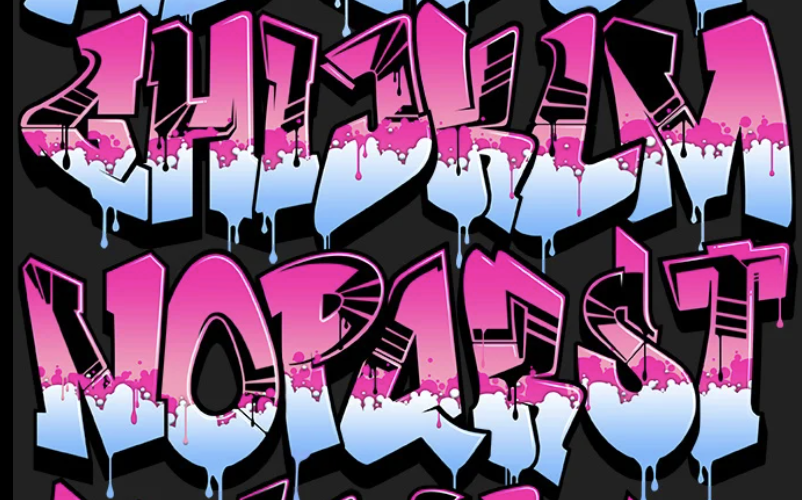Graffiti fonts have long been a captivating and dynamic form of artistic expression, transcending the boundaries of traditional typography. These visually striking typefaces, rooted in the vibrant street art culture, have evolved to become a powerful tool for designers, artists, and individuals seeking to infuse their work with a raw, rebellious energy. In this comprehensive article, we will embark on a journey to uncover the history, styles, and creative potential of graffiti fonts.

Graffiti Fonts
Contents
- 1 Introduction to Graffiti Fonts
- 2 The History and Evolution of Graffiti Fonts
- 3 Different Styles of Graffiti Fonts
- 4 Popular Graffiti Font Artists and Their Work
- 5 Using Graffiti Fonts in Design Projects
- 6 Tips for Creating Your Own Graffiti Fonts
- 7 Where to Find and Download Graffiti Fonts
- 8 Examples of Creative Uses of Graffiti Fonts
- 9 Graffiti Font Trends in the Design Industry
- 10 Conclusion
Introduction to Graffiti Fonts
Graffiti fonts are a unique and captivating typographic style that emerged from the underground world of street art. These fonts are characterized by their bold, dynamic, and often unconventional letterforms, which are inspired by the spontaneous and expressive nature of graffiti writing. Unlike traditional fonts, graffiti typefaces are not bound by the constraints of formal design, allowing for a free-flowing and organic aesthetic that reflects the rebellious spirit of the urban landscape.
The History and Evolution of Graffiti Fonts
The origins of graffiti fonts can be traced back to the 1970s, when the burgeoning graffiti art movement in cities like New York and Philadelphia gave rise to a new visual language. As graffiti writers sought to leave their mark on the urban canvas, they developed distinct lettering styles that were both visually striking and reflective of their individual artistic sensibilities. Over time, these unique letterforms evolved, giving birth to a diverse array of graffiti font styles that continue to captivate and inspire designers and artists worldwide.
Different Styles of Graffiti Fonts
Graffiti fonts encompass a wide range of visual styles, each with its own distinct characteristics and aesthetic appeal. Some of the most prominent graffiti font styles include:
- Bubble Lettering: Characterized by their rounded, inflated letterforms, bubble graffiti fonts exude a playful and energetic vibe.
- Wildstyle: Featuring intricate, interlocking letterforms and a sense of movement, wildstyle graffiti fonts are known for their complex and visually striking designs.
- Calligraphic Graffiti: Drawing inspiration from traditional calligraphy, these graffiti fonts showcase a more fluid and expressive approach to lettering.
- 3D Graffiti: Leveraging the illusion of depth and dimension, 3D graffiti fonts create a sense of volume and sculptural quality.
- Distressed Graffiti: With a weathered, grungy appearance, distressed graffiti fonts convey a sense of urban grit and authenticity.
Popular Graffiti Font Artists and Their Work
The world of graffiti fonts is home to a diverse array of talented artists, each with their own unique style and approach. Some of the most renowned graffiti font artists include:
- Seen: A pioneering figure in the graffiti art movement, Seen is renowned for his iconic wildstyle lettering and his influential role in shaping the evolution of graffiti fonts.
- Cope2: Known for his bold, energetic bubble lettering, Cope2 has left an indelible mark on the graffiti font landscape with his instantly recognizable style.
- Retna: Blending elements of calligraphy, hieroglyphics, and graffiti, Retna’s distinctive font style has been widely celebrated for its artistic sophistication and visual complexity.
- Niels “Shoe” Meulman: Bridging the gap between traditional calligraphy and graffiti, Shoe’s work has been instrumental in elevating graffiti fonts to new levels of artistic expression.
Using Graffiti Fonts in Design Projects
Graffiti fonts have become increasingly popular in the design industry, as creatives seek to infuse their work with a raw, edgy, and visually striking aesthetic. From album covers and event posters to packaging designs and branding initiatives, graffiti fonts offer a versatile and impactful way to capture the attention of audiences and convey a sense of rebellious creativity.
Tips for Creating Your Own Graffiti Fonts
Aspiring designers and artists can harness the power of graffiti fonts by exploring the process of creating their own unique typefaces. Here are some tips to get started:
- Observe and Analyze: Immerse yourself in the world of graffiti art, studying the various styles and techniques employed by master graffiti font artists.
- Experiment with Letterforms: Embrace a free-flowing and improvisational approach to lettering, allowing your creativity to guide the development of your font’s distinctive features.
- Incorporate Texture and Distress: Incorporate elements of weathering, dripping, and grit to imbue your graffiti font with a sense of authenticity and urban character.
- Refine and Digitize: Once you’ve established the foundation of your graffiti font, use digital tools to refine the letterforms and create a cohesive, scalable typeface.
- Share Your Creation: Consider sharing your graffiti font with the design community, either through online font marketplaces or by making it available for free download.
Where to Find and Download Graffiti Fonts
For designers and creatives seeking to incorporate graffiti fonts into their projects, there are numerous online resources available. Popular font marketplaces like FontSquirrel, DaFont, and Creative Market offer a wide selection of high-quality graffiti fonts, ranging from free downloads to premium typefaces. Additionally, many graffiti artists and designers sell their own custom font creations directly through their websites or online stores.
Examples of Creative Uses of Graffiti Fonts
Graffiti fonts have found their way into a diverse array of creative applications, showcasing their versatility and visual impact. From album covers and concert posters to street art murals and fashion branding, these dynamic typefaces have the power to transform ordinary designs into bold, attention-grabbing statements.
Graffiti Font Trends in the Design Industry
As the design industry continues to evolve, graffiti fonts have maintained a strong presence, reflecting the ongoing fascination with urban culture and the desire for authentic, rebellious aesthetics. Some of the notable trends in the world of graffiti fonts include the incorporation of digital glitch effects, the fusion of graffiti styles with traditional calligraphy, and the exploration of 3D and kinetic typography.
Conclusion
Graffiti fonts have emerged as a powerful and captivating form of artistic expression, transcending the boundaries of traditional typography and captivating designers, artists, and audiences alike. By exploring the rich history, diverse styles, and creative potential of these dynamic typefaces, we can unlock new avenues for visual storytelling and unleash the boundless creativity that lies within the world of graffiti fonts.
Discover the world of graffiti fonts and unlock your creative potential. Explore our curated collection of premium graffiti font packs and start infusing your designs with a bold, rebellious energy. Shop now and elevate your creative projects to new heights.
